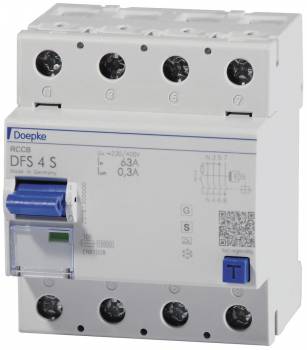Doepke DFS4 040-4/0,50-A S (09137905)
Installation > Modular devices / equipment installation > RCD

Doepke DFS4 040-4/0,50-A S (09137905)
| Lieske Part No. | 628340 |
|---|---|
| Mfg Part No | 09137905 |
| EAN-Code | 4014712091207 |
| Manufacturer | Doepke |
| Here only | 240,17 EUR
285,80 EUR incl. VAT
|
Further information for Doepke DFS4 040-4/0,50-A S (09137905)
Residual current circuit breakers (RCCBs) are components for implementing the protective measure 'protection by automatic shutdown of the power supply' in accordance with the requirements of VDE 0100 Part 410 or corresponding international installation regulations. Devices in the DFS 4 series are compact two- or four-pole residual current circuit breakers. In the standard version, they only take up four division units. While the DFS 4 version for alternating and pulsating direct residual currents is designed for three-phase networks, but can also be used in single-phase networks, there are special versions for single- or three-phase operation in the universal current sensitive versions (type B, type B+). Despite the compact dimensions, a large number of different tripping currents and characteristics are available for rated currents - depending on the version - up to 125 A. All devices are available in the 'HD' version, which is particularly suitable for use in harsh environments (tunnels, swimming pools, etc.). They also have large double-level terminals for accommodating large conductor cross-sections, a practical multi-function switch toggle and can be labeled with pre-made labels using free software. Switches with residual current characteristic A enable the detection of sinusoidal alternating and pulsating direct residual currents independent of the mains voltage. Any additional functions may be voltage-dependent. Selective residual current circuit breakers require a longer flow time of the residual current to be triggered than instantaneous switches. This enables selective shutdown in systems with staggered distributions, i.e. with RCCBs connected in series, in the event of a fault only the RCCB in whose immediately downstream system section the earth fault occurs will be triggered. Due to their long shutdown times and high rated residual currents, selective residual current circuit breakers only provide fire protection and fault protection (protection against indirect contact). Additional protection (protection against direct contact, personal protection) is therefore not possible. Standard devices are designed for monitoring circuits with a rated voltage of 230 V or 400 V and a rated frequency of 50 Hz. Features: - response delay for selective operation, - high immunity to surge fault currents and mains voltage-driven follow-on current pulses, - tripping independent of mains and auxiliary voltage, - sensitive to alternating and pulsating direct fault currents (type A), - small size for all rated currents, - high short-circuit strength, - double-sided double-deck terminals for large conductor cross-sections and busbar connections, - switch position indicator, - viewing window for labels, - multifunctional switch toggle with three positions: 'on', 'off', 'tripped', - neutral conductor on the left in standard version,for every four-pole device, N can be supplied optionally on the right at no extra cost. Mounting type: - Quick fastening on mounting rail. - Installation position as desired. - Feed direction as desired. Areas of use: - Main distribution boards in widely spread power supplies with TN-S, TT and TN-CS systems, e.g. for campsites, marinas, allotments, showgrounds. In most cases, selective residual current circuit breakers protect the cables from the main distribution board to the sub-distribution boards. - Use in TN-C networks and for protecting systems in which electronic equipment can cause smooth DC residual currents or residual currents with frequencies other than 50 Hz is excluded. Comprehensive protection is not provided here. For such applications, we recommend our universal current-sensitive residual current circuit breakers (type B or B+). Notes: - To ensure selectivity of the RCCB, the rated residual current of the selective RCCB must be selected at least one level higher than the

This is an offer of:
79279 Vörstetten
http://industry-electronics.com
Tel. 07666/88499-0
Fax. 07666/88499-111
Diesen Artikel finden Sie unter:
industry-electronics.com/artikel/628340

Lieske Elektronik e.K.
Reutener Str. 1079279 Vörstetten
http://industry-electronics.com
Tel. 07666/88499-0
Fax. 07666/88499-111
Diesen Artikel finden Sie unter:
industry-electronics.com/artikel/628340
